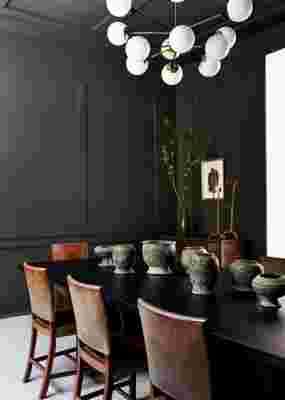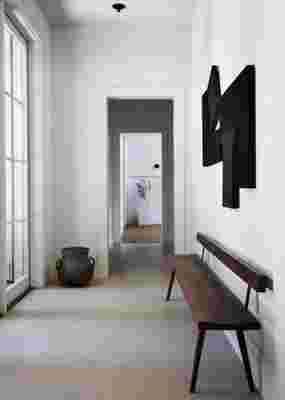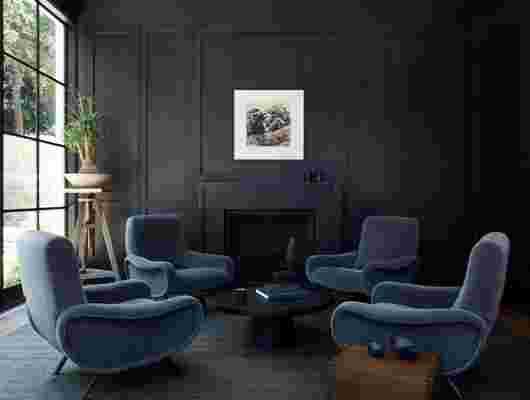Building a house from the ground up is a major undertaking for anyone. But for former TV executive Sheila Bouttier, the process was nothing short of revelatory. While overseeing the construction and decoration of her family’s home in Los Angeles, a modern stone-walled cottage surrounded by gardens, she found a new passion that led to a completely unexpected career path. Just over a year ago, Bouttier opened Galerie Provenance, a design gallery specializing in vintage furniture from Europe. The idea came to her after making several trips to France, Sweden, Denmark, and the U.K. in search of pieces by the likes of Jean Prouvé, Charlotte Perriand, and Kaare Klint, whose lean sculptural designs could complement her unique art collection (more on this later).

Black walls and a matching dining table (from Oliver Gustav Studio) help create a masculine, sophisticated atmosphere in the dining room. The mahogany-and-leather chairs are midcentury pieces designed by Kaare Klint. In the back is an 18th-century Italian commode, topped by antique iron candlesticks and an ink wash painting by Benjamin Abramowitz.
“I applied my executive skills to the task,” says Bouttier, referring to her yearslong work as a senior vice president at Telepictures and ABC Daytime. “Very quickly I realized it did not make sense to bring only one or two pieces to the States, so I got a container, and then a second, and then it became a business.” Bouttier saw an opportunity, yes, but more than anything she just fell in love with old furniture. “It’s like these artifacts I was finding took on lives of their own,” she says. “I wondered what they’d seen and lived through, and that really interested me, their layers of depth and soul.”
Her home, which she shares with her husband, Brett Bouttier, and their two children, is filled with midcentury gems interspersed with a handful of antiques. In the main hallway, an Italian travertine oval table from the ’70s is paired with two wooden stools by Pierre Chapo, also from the ’70s, and an antique Sultanabad runner. Steps away is the formal living room, where a custom sofa and armchair inspired by Jean Royère’s curvaceous shapes of the 1950s help soften the sharp lines of Pierre Jeanneret’s iconic “Easy” chairs. The space also features a brass lamp by Pierre Folie from the 70s, a round elmwood coffee table from the 60s, and a gilded mirror atop a French limestone mantel, both believed to be from the early 1800s. Like elsewhere in the 6,500-square-foot, six-bedroom property, the combination is harmonious without being obvious, exuding a polished yet lived-in atmosphere.

A wooden bench by Jean Touret & the Artisans of Marolles, part of a series designed in the ’50s that was guided by the concept of minimalism and simplistic integrity, seems like a natural fit for a geometric wall sculpture by Benjamin Abramowitz. The flush-mounted ceiling light is by Atelier de Troupe.
Bouttier—who consulted with a couple of interior designers—considered each item carefully to make sure it could hold its own inside the home’s spacious, high-ceilinged rooms. Mostly, however, she thought about how they would enhance her most treasured possession: a collection of more than 60 works by her grandfather, the late American artist Benjamin Abramowitz. Starting in the 1940s, Abramowitz produced a highly regarded series of abstract paintings, sculptures, and drawings, some of which are held by the National Gallery of Art in Washington, D.C., and the Metropolitan Museum of Art in New York. “I’m his only grandchild,” says Bouttier, who manages Abramowitz’s estate with her mother. “We built the house partly as a backdrop for his body of work.”
While the interior of the house is indeed like a gallery, displaying striking, strategically hung artworks on walls that go up to 30 feet in some areas, the stone and board-and-batten exterior is no less appealing. Architect William Hefner designed the property, which sits on a half acre of land, to be ensconced in a series of gardens with lush groves that call to mind classic California estates like San Ysidro Ranch. “It took us a while to find a piece of land that was nestled into nature and also part of the city,” says Brett Bouttier, an entrepreneur. “Hefner really got what we were trying to create, which is a contemporary retelling of something traditional.”

